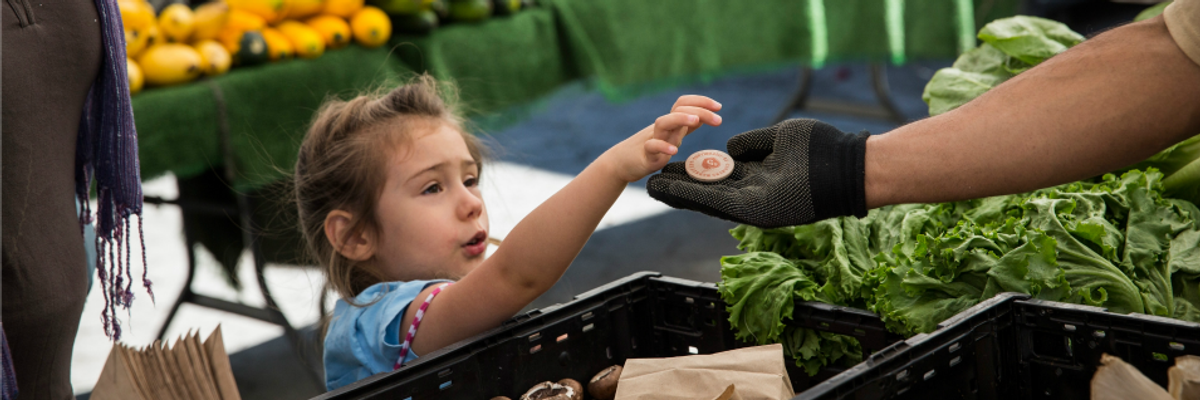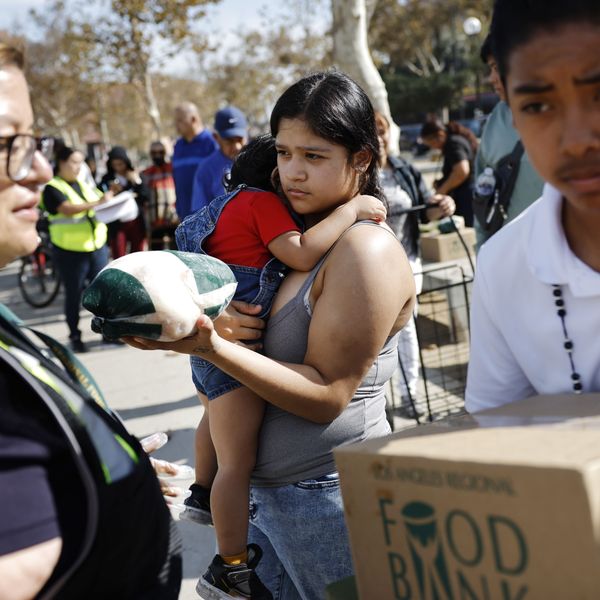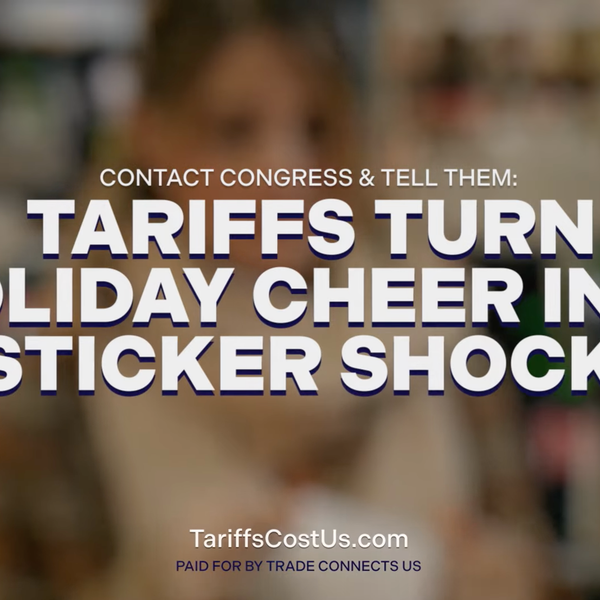
A girl pays for her mother's groceries using Electronic Benefits Transfer (EBT) tokens, more commonly known as food stamps, at a farmers' market in New York City. (Photo: Andrew Burton/Getty Images
Blue Apron? 'Um, No.' Anti-Hunger Advocates Decry Trump's Food Box Proposal for Nation's Poor
The USDA is attempting to promote its plan to assign specific shelf-stable foods to families who rely on food stamps as "America's Harvest Box"—although the proposed food boxes will contain no fresh foods
Amid the outcry over President Donald Trump's proposed 2019 budget--which also calls for massive spending cuts for education, healthcare, and foreign aid--policy experts and anti-hunger groups zeroed in on Tuesday on the administration's plan to replace food stamps with boxes that would contain foods pre-selected by the Agriculture Department.
Mick Mulvaney, director of the Office of Management and Budget, likened the proposal to Blue Apron, the popular meal-delivery service. But critics noted that the company's mission of simplifying meal preparation for busy households would be replaced by a bureaucratic attempt to dictate which foods families could have, in the interest of saving money for the government.
\u201cHearing that the Trump Admin is selling this as the \u201cBlue Apron-ing\u201d of SNAP. \n\nUm, no. https://t.co/FzgVRv8yw4\u201d— Chad Bolt (@Chad Bolt) 1518458481
"With Blue Apron, you get to pick your meals and decide when they come," noted journalist Bryce Covert. "And it gives you all the ingredients you need to complete it. Under Trump's plan, the government decides what you get and when you get it. You have no say. Is your oven off because you couldn't pay the gas bill? Too bad, you got canned food that needs to be heated up."
Under Trump's proposal, families receiving more than $90 in Supplemental Nutrition Assistance Program (SNAP) benefits--about 80 percent of eligible families--would receive half of their benefits in the monthly food boxes, which would contain shelf-stable milk, juice, grains, cereals, pasta, peanut butter, beans and canned meat, fruits and vegetables. After receiving the box, the average SNAP household would be left with about $127 per month to buy fresh produce and other foods of their choosing.
Anti-hunger advocates point out that the pre-selected foods would not be suitable for SNAP recipients with special dietary needs.
"It boggles the mind how that would play out," Kathy Fisher, policy director at Philadelphia's Coalition Against Hunger, told the Washington Post. "We know SNAP works now, when people can choose what they need. How they would distribute foods to people with specialized diets, or [to people in] rural areas...It's very expensive and very complicated."
Others pointed out that the USDA's proposed name for the packages, "America's Harvest Box," is a misnomer.
\u201cShocking anti-hunger advocates, the Trump admin is proposing to replace half of food stamp money with a box of government-selected food they\u2019d deliver monthly. They\u2019d call it a \u201cHarvest Box\u201d even though it wouldn\u2019t include anything fresh. https://t.co/jjc9Edgp0S\u201d— Daniel Dale (@Daniel Dale) 1518497471
"This action would not only destabilize attempts to bring more healthy, fresh foods into the homes of America's food insecure, but would keep dollars out of local grocery stores and farmers markets, which are critical assets to all communities," Jordan Rasmussen, a policy associate at the Center for Rural Affairs, told Politico.
An Urgent Message From Our Co-Founder
Dear Common Dreams reader, The U.S. is on a fast track to authoritarianism like nothing I've ever seen. Meanwhile, corporate news outlets are utterly capitulating to Trump, twisting their coverage to avoid drawing his ire while lining up to stuff cash in his pockets. That's why I believe that Common Dreams is doing the best and most consequential reporting that we've ever done. Our small but mighty team is a progressive reporting powerhouse, covering the news every day that the corporate media never will. Our mission has always been simple: To inform. To inspire. And to ignite change for the common good. Now here's the key piece that I want all our readers to understand: None of this would be possible without your financial support. That's not just some fundraising cliche. It's the absolute and literal truth. We don't accept corporate advertising and never will. We don't have a paywall because we don't think people should be blocked from critical news based on their ability to pay. Everything we do is funded by the donations of readers like you. Will you donate now to help power the nonprofit, independent reporting of Common Dreams? Thank you for being a vital member of our community. Together, we can keep independent journalism alive when it’s needed most. - Craig Brown, Co-founder |
Amid the outcry over President Donald Trump's proposed 2019 budget--which also calls for massive spending cuts for education, healthcare, and foreign aid--policy experts and anti-hunger groups zeroed in on Tuesday on the administration's plan to replace food stamps with boxes that would contain foods pre-selected by the Agriculture Department.
Mick Mulvaney, director of the Office of Management and Budget, likened the proposal to Blue Apron, the popular meal-delivery service. But critics noted that the company's mission of simplifying meal preparation for busy households would be replaced by a bureaucratic attempt to dictate which foods families could have, in the interest of saving money for the government.
\u201cHearing that the Trump Admin is selling this as the \u201cBlue Apron-ing\u201d of SNAP. \n\nUm, no. https://t.co/FzgVRv8yw4\u201d— Chad Bolt (@Chad Bolt) 1518458481
"With Blue Apron, you get to pick your meals and decide when they come," noted journalist Bryce Covert. "And it gives you all the ingredients you need to complete it. Under Trump's plan, the government decides what you get and when you get it. You have no say. Is your oven off because you couldn't pay the gas bill? Too bad, you got canned food that needs to be heated up."
Under Trump's proposal, families receiving more than $90 in Supplemental Nutrition Assistance Program (SNAP) benefits--about 80 percent of eligible families--would receive half of their benefits in the monthly food boxes, which would contain shelf-stable milk, juice, grains, cereals, pasta, peanut butter, beans and canned meat, fruits and vegetables. After receiving the box, the average SNAP household would be left with about $127 per month to buy fresh produce and other foods of their choosing.
Anti-hunger advocates point out that the pre-selected foods would not be suitable for SNAP recipients with special dietary needs.
"It boggles the mind how that would play out," Kathy Fisher, policy director at Philadelphia's Coalition Against Hunger, told the Washington Post. "We know SNAP works now, when people can choose what they need. How they would distribute foods to people with specialized diets, or [to people in] rural areas...It's very expensive and very complicated."
Others pointed out that the USDA's proposed name for the packages, "America's Harvest Box," is a misnomer.
\u201cShocking anti-hunger advocates, the Trump admin is proposing to replace half of food stamp money with a box of government-selected food they\u2019d deliver monthly. They\u2019d call it a \u201cHarvest Box\u201d even though it wouldn\u2019t include anything fresh. https://t.co/jjc9Edgp0S\u201d— Daniel Dale (@Daniel Dale) 1518497471
"This action would not only destabilize attempts to bring more healthy, fresh foods into the homes of America's food insecure, but would keep dollars out of local grocery stores and farmers markets, which are critical assets to all communities," Jordan Rasmussen, a policy associate at the Center for Rural Affairs, told Politico.
Amid the outcry over President Donald Trump's proposed 2019 budget--which also calls for massive spending cuts for education, healthcare, and foreign aid--policy experts and anti-hunger groups zeroed in on Tuesday on the administration's plan to replace food stamps with boxes that would contain foods pre-selected by the Agriculture Department.
Mick Mulvaney, director of the Office of Management and Budget, likened the proposal to Blue Apron, the popular meal-delivery service. But critics noted that the company's mission of simplifying meal preparation for busy households would be replaced by a bureaucratic attempt to dictate which foods families could have, in the interest of saving money for the government.
\u201cHearing that the Trump Admin is selling this as the \u201cBlue Apron-ing\u201d of SNAP. \n\nUm, no. https://t.co/FzgVRv8yw4\u201d— Chad Bolt (@Chad Bolt) 1518458481
"With Blue Apron, you get to pick your meals and decide when they come," noted journalist Bryce Covert. "And it gives you all the ingredients you need to complete it. Under Trump's plan, the government decides what you get and when you get it. You have no say. Is your oven off because you couldn't pay the gas bill? Too bad, you got canned food that needs to be heated up."
Under Trump's proposal, families receiving more than $90 in Supplemental Nutrition Assistance Program (SNAP) benefits--about 80 percent of eligible families--would receive half of their benefits in the monthly food boxes, which would contain shelf-stable milk, juice, grains, cereals, pasta, peanut butter, beans and canned meat, fruits and vegetables. After receiving the box, the average SNAP household would be left with about $127 per month to buy fresh produce and other foods of their choosing.
Anti-hunger advocates point out that the pre-selected foods would not be suitable for SNAP recipients with special dietary needs.
"It boggles the mind how that would play out," Kathy Fisher, policy director at Philadelphia's Coalition Against Hunger, told the Washington Post. "We know SNAP works now, when people can choose what they need. How they would distribute foods to people with specialized diets, or [to people in] rural areas...It's very expensive and very complicated."
Others pointed out that the USDA's proposed name for the packages, "America's Harvest Box," is a misnomer.
\u201cShocking anti-hunger advocates, the Trump admin is proposing to replace half of food stamp money with a box of government-selected food they\u2019d deliver monthly. They\u2019d call it a \u201cHarvest Box\u201d even though it wouldn\u2019t include anything fresh. https://t.co/jjc9Edgp0S\u201d— Daniel Dale (@Daniel Dale) 1518497471
"This action would not only destabilize attempts to bring more healthy, fresh foods into the homes of America's food insecure, but would keep dollars out of local grocery stores and farmers markets, which are critical assets to all communities," Jordan Rasmussen, a policy associate at the Center for Rural Affairs, told Politico.

